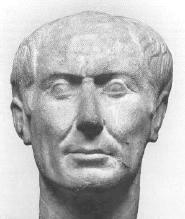 Gaius
Julius Caesar Gaius
Julius Caesar
ca. 100-44 BC.
 Julius
Caesar's War Commentaries: Julius
Caesar's War Commentaries:
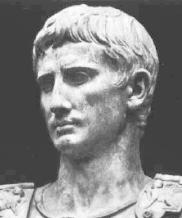 Caesar Augustus
(Gaius Octavius) (31 BC - 14 AD) Caesar Augustus
(Gaius Octavius) (31 BC - 14 AD)
63 BC - 14 AD. Emperor, 27 BC
- 14 AD.
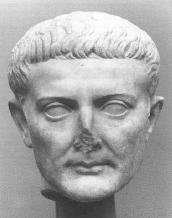 Tiberius
(14-37 AD) Tiberius
(14-37 AD)
Augustus
brought his step-son Tiberius to co-rule with him in his later days,
giving indication of his desires for a successor. The 23 years of
sole rule by Tiberius after his father's death marked a continuation of
Augustus' policies. Tiberius also possessed much of the
diplomatic skill and energy of Augustus – and was undoubtedly the best
of the Julio-Claudian successors.
The reign of Tiberius
was generally a peaceful time for Rome – though turbulent within the
higher reaches of Roman politics as Tiberius gradually descended into a
highly paranoid condition, executing many around him that he suspected
of personal disloyalty (including many of his personal
relatives). This grim situation continued all the way to his
death in 37 AD.
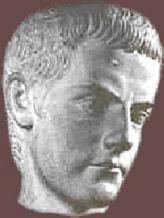 Caligula
(Gaius) (37-41 AD) Caligula
(Gaius) (37-41 AD)
Tiberius was succeeded by his grandnephew Gaius or "Caligula" (little boots) who was probably insane. Ultimately, he was a wastrel ruled by his grand lusts--which
over time turned into true insanity. His rule was thus not much less violent and he and his family were assassinated after only four years of his rule.
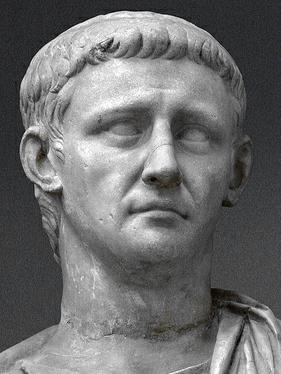 Claudius (41-54
AD) Claudius (41-54
AD)
Caligula's
uncle (and Tiberius's nephew) Claudius replaced him – just as the
Senate was giving thought to restoring the Republic. The army's
Praetorian Guard stepped in and declared Claudius emperor – putting an
end to the question. (This would mark the beginning of the role
of the Praetorian Guard as emperor-makers – as well as emperor
"unmakers" or assassins, according to their own political
preferences). Claudius probably survived the purges of his
relatives Tiberius and Caligula – mostly because he was considered to
be an unlikely threat to these men, perhaps because of some kind of
disability.
He basically continued
to move the Empire toward the vision that had once directed the actions
of Augustus. He strengthened the Imperial bureaucracy. He completed
the incorporation of client-states into the direct rule of the empire.
He succeeded in bringing southern Britain under Roman rule. But he
lacked polish and was the object of ridicule for his personal ways.
But he too also developed violent suspicions of those around him, in
particular a number of Senators. In 54 AD he was probably
poisoned – possibly by his wife (who was certainly afraid that he was
going to pass over her son Nero in favor of another imperial candidate).
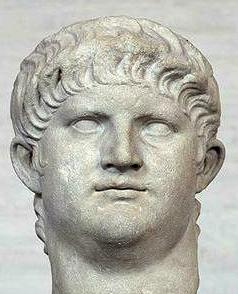 Nero
(54-68 AD) Nero
(54-68 AD)
Thus
Nero, with the help of his conniving mother (whom he will execute in 59
AD) became emperor at age 16. He started off his reign fairly
popular with the people – whom he was always trying to please. He did
what he could to beautify Rome, building theaters and sponsoring
gladiatorial contests to amuse the people. However his projects
grew increasingly extravagant and became a serious burden on the
finances of the Empire. Also, arrogant and by nature suspicious,
Nero became increasingly paranoid and ruthless (even murderous) to a
large circle of individuals immediately around him, including his old
tutor, Seneca.
The Burning of Rome.
In 64 much of Rome burned (actually not an entirely uncommon
occurrence). Rumors were that he himself had done this in an
effort to clear the Roman slums to make way for his expensive,
ever-expanding urban beautification projects. According to the
historian Tacitus, Nero attempted to deflect the blame for the fire on
to the Christians (who were growing rapidly in number in Rome – and
also gaining in a bad reputation for their un-Roman "secret'
ways). He attempted to validate his own accusations against the
Christians by offering the Roman public the entertaining spectacle of
horrible deaths inflicted on members of this "vile sect."
The subduing of Britain.
During his reign he encountered – and largely overcame – rebellions in
various parts of the Empire, most notably in Britain (Queen Boudica's
Revolt of 60-61). Beginning in AD 43, under the Emperor Claudius,
the Romans had begun the process of subduing Britain, one region at a
time. By 47 Britain south of the Humber River and east of Wales
was under Roman control. By AD 60 (Nero was ruling Rome by this
time) the Roman legions had destroyed the Druid religious or political
center at Mona (or Anglesey). But the following year, 61, a major
Celtic uprising led by the Celtic Queen Boudica threatened to reverse
these Roman victories. Emperor Nero was even considering
abandoning Britain when Roman legions under Suetonius defeated a huge
Celtic army – possibly 10 times the size of the Roman army – somewhere
along the main Roman road (later, in the Middle Ages, termed "Watling
Street") which ran from the English Channel to Wales.
The first Jewish-Roman war AD 67-70.
He actually demonstrated diplomatic talent in the way he resolved a
dispute with Parthia (the former Persia) over the kingdom of Armenia
(AD 63) and in securing a peace between these two empires that would
last 50 years.
But eventually revolt also touched the heart of Rome itself: Nero found
himself facing down rebellion and conspiracy – from many different
directions. Even the army was growing unreliable in its support
of its emperor. Finally hearing of a major rebellion brewing, and
finding that no one supported him any longer, he took his own life (AD
68). He was only 30 years old at his death. And with his death
the Julio-Claudian line came to an end.
A Period of Confusion
(68-70 AD)
When Nero died there was a rather thorough
murder of the last of the successors to the Julio-Claudian line of emperors.
This in turn produced a civil war which was decided not by Roman political
leadership but by the might of the contending Roman armies. After
a two-year struggle among a number of major contenders, Vespasian emerged
as the remaining candidate for the imperial title.
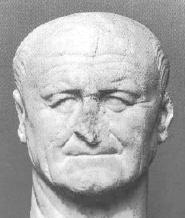 Vespasian
(70-79 AD) Vespasian
(70-79 AD)
Lacking any special family ties or
noble line Vespasian attempted to undergird his hold over the principate
by assuming for himself the title of Caesar. Thus the term
Caesar
now referred not to the Italian family that had once ruled the Roman principate--but
was transformed during Vespasian's rule into a political title or office.
Caesar
now was a title of special imperial authority.
His rule was further undergirded
by strengthening the move started under Augustus to recommend to the Romans
(especially those with Eastern roots where emperor-worship had a natural
history) special reverence for the imperial caesar--to view the
princeps as a ruler with special sacred authority within the empire.
The last year of his rule marked
the beginning of the conquest of northern Britain (under General Agricola):
78-84.
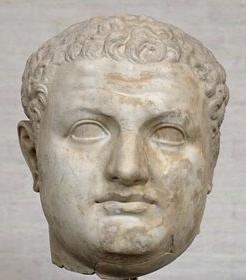 Titus (79-81) Titus (79-81)
Vespasian's
eldest son Titus succeeded his father as emperor. He had
distinguished himself under his father's rule as the commander of the
eastern legions that forced Judea back into submission. As
emperor his rule was short – and troubled. Pompeii was destroyed
by the eruption of Mount Vesuvius in 79 and in 80 much of Rome was
destroyed by fire. Otherwise he too was proving to be an
excellent administrator. But Titus died in 81 – seemingly of
natural causes.
Domitian (81-96
AD)
Titus's
place was immediately taken by his brother Domitian ... thanks to the
support of the Praetorian Guard. Domitian was more arrogant –
assuming tremendous powers as the society's divinely ordained
enlightened despot in his effort to rebuild the imperial character of
Rome ... including the physical rebuilding of the city itself, which
had suffered tremendous damage from the recent fires and civil war.
No effort was made to continue the pretense of the Republic's
existence. He ignored the Senate (which grew to hate him) and
surprisingly gave no special favors to his family, very unusual in
imperial politics. He presided over a tightly organized and
surprisingly uncorrupt bureaucracy. He spent most of his time
away from the capital city, leading battles or conducting inspection
tours ... and thus the seat of his government tended to be wherever he
himself was located. It was during his emperorship that Celtic
Britain was finally defeated (by General Agricola) and brought into the
Roman Empire ... except for the northern portions (Scotland) whose
troops managed to escape the grip of the Roman legions.
He cultivated the support of the crowds – with lavish gladiatorial
games in the new Coliseum and through distributions of monies to the
residents of Rome. Surprisingly his regime ended with money still
in the state treasury, probably because of all the wealth he
accumulated by seizing the property of people he had begun to
fear. In 96 he was assassinated in a plot directed by his
own court officials. But in any case, this brought the Flavian
line to an end.
Nerva (96-98)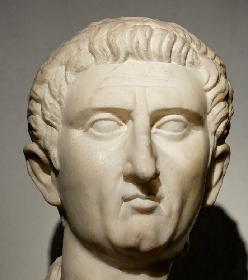
Nerva
was raised in political, not military circles, and his accession to
power was via the Senate, where he was popular. He immediately
freed the people that Domitian had imprisoned and restored to them
their property he had confiscated. He also attempted to cultivate
popular support in Rome through the lowering of taxes and extensive
welfare grants to the poor. But this created financial problems
for the government. Also Domitian had been popular with the Roman
army. In fact, the Praetorian Guard seized Nerva and forced him
to turn over to them the individuals involved in the death plot against
Domitian. Nerva's rule was brief – he was probably chosen by the
Senate because he was old and childless – and he died of a stroke after
only two years of rule.
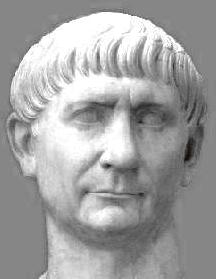 Trajan
(98-117) Trajan
(98-117)
Under
the insistence of the Praetorian Guard, Nerva had named the prominent
general Trajan as his "adopted son (successor). As emperor he
proved to be a capable administrator, as well as a promoter of further
military successes for Rome. He built in Rome both a new forum
and market as well as some important ceremonial landmarks (Trajan's
column). But it is in the area of military and diplomatic policy
that he is best remembered. Under his rule the Empire reached its
furthest extent.
In 106 Trajan forcibly incorporated into the Empire the kingdom of
Dacia (roughly present-day Romania) and the Nabataean kingdom
(present-day Jordan and northwestern Saudi Arabia). In 113 he
turned on Parthia (in present day Iran and Iraq). The Parthian
king Osroes had forced on Armenia a king of Osroes's choosing – in
violation of the Roman-Parthian treaty secured by Nero which had made
Armenia (in the land between the Black Sea and the lower Caspian Sea) a
joint protectorate of both these two great empires. Thus Trajan marched
into Armenia and placed his own man on the Armenian throne. Then
in 116 Trajan continued his conquest into Parthia itself, seizing
Babylon, Ctesiphon, and Susa, deposing Osroes, and placing his own
ruler on the Parthian throne.
But the venture overtaxed his energies – and he faced rebellion in many
places in the newly expanded Empire. Mesopotamia was restless,
and once again the Jews rose up in rebellion against Rome. Very ill, he
managed to return to Rome before he died there in 117. The Romans
knew that they had lost a great Emperor – one of their very best.
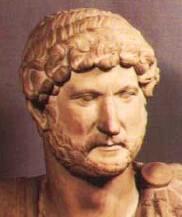
Hadrian
(117-138)
HA
distant relative of the childless Trajan, and supported by Trajan's
wife Plotina, Hadrian was named as successor as Trajan lay dying.
The Senate quickly endorsed the choice. Hadrian had served with
Trajan as something of a military administrator during Trajan's
military campaigns – and was in fact left by Trajan as Governor of
Syria in order to pacify the rebellious Jews.
Hadrian sought to be an excellent administrator and diplomat rather
than conqueror. He chose to spend more than half of his time as
Emperor outside Italy, conducting important inspection tours of the
various provinces of the Empire – enabled largely because his political
position in Rome with the Senators was so secure. Upon accession
to the imperial throne he quickly surmised that holding Mesopotamia
would prove to be more taxing on Roman strength than it would be worth
– and acknowledged Parthia's claim to that region. But elsewhere
Hadrian was determined to hold the line of defense against Rome's
tribal enemies – erecting walls and fortresses in protection of Rome's
now rather "fixed" borders in northern Britain, along the Rhine, along
the Danube, and between these two rivers (the Rhine-Danube limes).
He saw himself as something of an intellectual as well. He
greatly admired Greek philosophy and literature (he even started the
fashion of wearing a beard, Greek-style) and considered himself a poet
and Stoic and Epicurean philosopher.
The end of his rule was marked by a major crisis in Judea – where he
faced massive and destructive revolt by the Jews, led by Bar
Kokhba. The problem began when he rebuilt Jerusalem (destroyed in
the earlier 67-70 Jewish rebellion) – but as a Roman city, Aelia
Capitolina. He also erected a temple to Jupiter on the
foundations of the leveled Jewish Temple. And he decreed an end
to the "barbaric" Jewish practice of circumcision. This proved to
be too much to the Jews and in 132 they rose up again in rebellion. The
Jews proved to be very difficult to tame: he possibly lost an entire
legion to the Jews, and had to call in legions from all around the
Empire to finally bring the Jews to submission in 135. The loss
of Jewish life and social position was enormous. A vindictive
Hadrian dedicated himself to rooting out Judaism from the Empire.
His health was failing and he twice named a successor (the first one
died ahead of him) as he saw his end coming nearer. His choice
was disputed by relatives who attempted a coup – and whom he put to
death. But in 138 his death finally arrived.
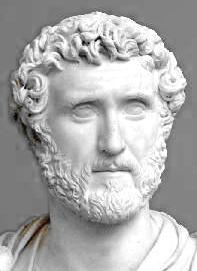
Antoninus Pius
(138-161)
Antoninus was given
the title "Pius" (pious) for his devotion (piety) to his benefactor
Hadrian, whom he pressured the Senate to deify after Hadrian's
death. Importantly also, his devotion was demonstrated in his
willingness to honor Hadrian's deathbed request to Antoninus to adopt
as his own sons two individuals – who would later become the emperors
Marcus Aurelius and Lucius Verus.
Antoninus did not come to prominence as a military man – nor did he
ever develop any relationship with any of the legions as had those
before and after him. His rule was the most peaceful of any in
the long run of the Empire – though he had to deal with relatively
small military disturbances from time to time. He never left
Italy to personally face disturbances, but always worked through Rome's
governors – drawing praise from many for his relatively peaceful
handling of Roman politics. However this seemed to have produced
the impression of Roman weakness in the estimation of many of Rome's
enemies (such as the ever troublesome Parthians) – which his successors
would have to deal with.
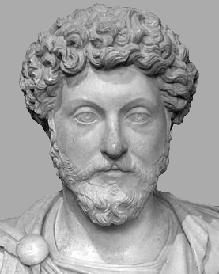 Marcus
Aurelius (161-180) Marcus
Aurelius (161-180)
Marcus
had the very best education of the time and demonstrated a keen
intellect very early in life. He had a natural affinity for
philosophy – which would reveal itself later when he became
Emperor. Upon his accession he insisted his younger adoptive
brother Verus serve as co-emperor – as a way of keeping the immense
army under imperial command, rather than the command of the generals –
while Rome fought off Germans and Parthians simultaneously on two
widely separated fronts.
The German tribes had
taken advantage of Antoninus's softness and were regularly crossing the
Roman border along the Rhine and Danube Rivers (pressure from tribal
peoples further east was also part of the reason). In 166 this
situation became very serious when the Persian Sarmatians raided the
borderlands of the eastern Danube and the Marcomanni, Lombards and
other German tribes crossed the Danube in huge numbers. Both Marcus and
Verus led the counterattack of the Roman Legions. But they were
unable to subdue their tribal enemies. Then when in 169 Varus
died, Marcus was left alone to deal with the situation – which merely
grew worse. The Marcomanni seemed unstoppable in their forays
into northern Italy, while other tribes were invading Macedonia and
Greece. Eventually Marcus got the Germans settled down – but by
accepting them as frontier settlers along the Danube all along the way
up to Bohemia (today's Hungary and Czech Republic).
In the meanwhile, the
Parthians had been undergoing a military revival and in 161 assaulted –
and defeated – Roman legions in Armenia and Syria. Varus was sent
out to deal with the Parthian problem ... and by 166 Varus – or
actually his general Gaius Cassius – captured the Parthian capital,
Ctesiphon, and subdued the Parthians. In 172 a revolt broke out
in Egypt – and again Cassius came to the rescue.
When in 175 a rumor
broke out that Marcus Aurelius had died, Cassius moved to have himself
declared Emperor by his political and military supporters in the East
(principally Syria, Palestine, and Egypt). Although the
misunderstanding was quickly cleared up, the Empire found itself caught
in a civil war. But Cassius's extensive support in Rome's eastern
provinces could not measure up to Marcus's overall support – and the
rebellion ended when one of Cassius's own centurions murdered
him. Ever the Stoic, Marcus was actually saddened by the whole
misadventure.
As ruler of a mighty
empire, there was something Solomon-like about Marcus Aurelius.
From 170 until his death in 180, he recorded his thoughts (in Greek) on
life, death, virtue, human purpose, etc. – that had all the qualities
of Solomon's philosophical reflections found in Ecclesiastes in the
Hebrew Bible (or even of Buddha's teachings about the folly of human
desire). His writings were later collected into a single work,
Meditations. It is a classic in Stoic thought.
In 178 he was forced
to turn his attentions back to the Germans along the Danube. He
again defeated the Germans soundly. The possibility of annexing
Bohemia to the Empire now presented itself. But Marcus's health was
failing him and the idea had to be abandoned. He died in 180 at
Vindobona (Vienna) along the German border.
 Marcus
Aurelius' major works or writings:
Meditations
(167 AD) Marcus
Aurelius' major works or writings:
Meditations
(167 AD)
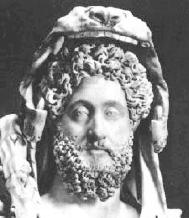 Commodus
(180-192) Commodus
(180-192)
Commodus,
Marcus Aurelius' son, brings the period of the "Five Good Emperors' to
an end. His rule marks the transition to very troubled times for
the Roman Empire. From 177 (at age 15) Commodus had been
co-emperor with his father – and it was hoped that with his father's
death he would be able to continue the good government of his
father. It was not to be. Although his rule began well, a
conspiracy in 182 (promoted primarily by members of his own family) to
assassinate him turned him paranoid. And from paranoia he slipped
into insanity.
Commodus was never really interested in administering the Empire – and
left the task to personal favorites, while he indulged himself in
sports at the family estates outside Rome. In Rome itself
political infighting increased within the upper ranks of Roman politics
– which made the direction of the Empire increasingly chaotic and at
times bloody. More intrigue drove Commodus deeper into isolation
at his family estates. Meanwhile corruption was overtaking the
governance of Rome. Commodus at the same time was becoming more
murderous in his dealings with those maneuvering to take up the reins
of government he himself had dropped.
Commodus was falling increasingly into insanity. He loved to
project himself as Hercules, a god of great physical strength. He
renamed Rome after himself, termed all Romans as "Commodians,"
redrafted the months of the calendar in using his own twelve names for
the months of the year. He did this less out of guile than out of
a case of increasing simple-mindedness. But it was his behavior
in the public arena that finally braced the Senate sufficiently to
organize his death (he would entertain Roman crowds with his slaughter
of hundreds of animals and hundreds of disabled Romans – and hold
hundreds of bloodless gladiatorial combats, which he always "won,' of
course). Finally in 192 he was strangled in his bath by a
wrestler that the Senate had paid to do the job.
Unlike his five predecessors, Commodus had made no arrangements for a
smooth succession upon his death. Roman politics fell into
further chaos. Over the next year there were five different
generals who laid claim to the title of Emperor. Assassinations
and bribes followed in rapid succession as claimants attempted to line
up soldiers and Senators behind their claim to the throne.
Another Period
of Confusion (192-193)
Pertinax (192-193) was chosen emperor
but was murdered soon thereafter by the Praetorian guard. They in
turn offered the imperial position to Didius Julian (133-193). But
he was overthrown and executed by Septimus Severus when the soldiers of
the latter marched on Rome and proclaimed him emperor in 193.
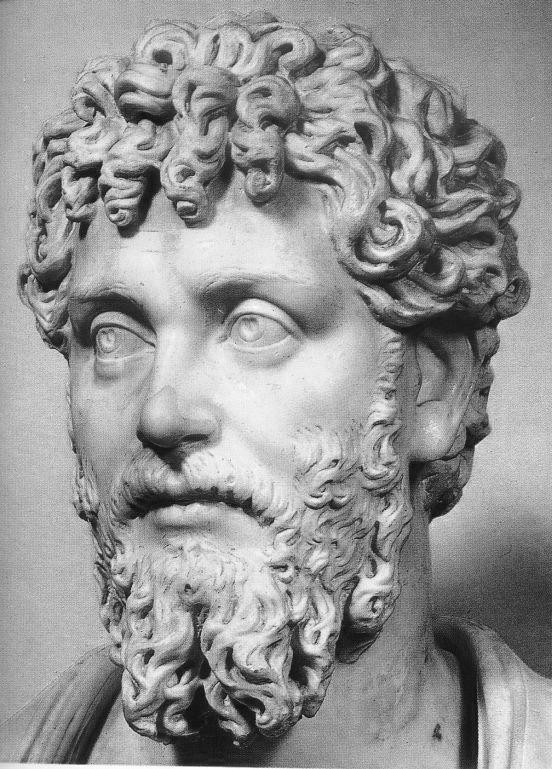 Septimus
Severus (193-211) Septimus
Severus (193-211)
146-211. Begins the period of
rule by soldier-emperors--in which the imperial title is determined by
a power struggle among Roman generals and their armies. He was the
most able of the lot. He did not seek confirmation of his rule from
the Senate--and in fact ignored that body during his tenure. The
Roman army was devoted entirely to himself and his family. But constantly
challenged by contenders, draining off Roman energies in power struggles
for the imperial position.
He was a Roman general from Africa, serving at the time in Pannonia
(modern Hungary and Serbia) and was declared emperor in 193 by his
troops. He marched on Rome and seized and murdered one of the
remaining claimants, then the following year (194) defeated in battle
in Asia Minor another of the contenders. Finally in 197 Septimius
Severus defeated the last of the remaining competitors in Gaul.
He was a military dictator who replaced the untrustworthy Praetorian
Guard with Rome-based soldiers loyal to himself personally – and
executed a scores of Senators and replaced them also with
supporters. Then he went after Parthia in 197, sacking the
capital, Ctesiphon, and restored northern Mesopotamia to the Roman
Empire. He expanded the army in size nearly doubled the wages of
the soldiers – thus securing his popularity among and power over the
military. This all was made possible by increasing the taxes on
the citizenry. But his attack on the political and economic
corruption that had developed under Commodus, an action that was a very
popular with the general citizenry, helped offset the burden of
increased taxes.
Despite his own bold personality, Severus allowed himself to come under
the influence of a series of very powerful prefects of the Praetorian
Guard, in particular his cousin and friend Plautianus who almost ran
the empire for Severus. Eventually Plautianus overreached himself
and he was put to death (205). But the next two prefects proved
to be even more powerful (though better behaved!) than Plautianus.
Severus ended his days personally directing military operations against
Rome's tribal enemies who were constantly threatening Rome's
borderlands. 208 he traveled to Britain in order to extend Roman
rule even to northern Scotland. In the process his troops
slaughtered countless Scottish Celts .... but he also lost 50,000 of
his own men. In late 210 he became ill while still in Britain
... and died early the following year.
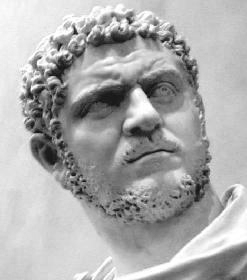 Caracalla (Antoninus)
(211-217) Caracalla (Antoninus)
(211-217)
Both
of Severus's sons succeeded him to the throne upon his death. But
Caracalla (actually a nickname derived from the Gallic hood he
typically wore) had his brother and brother's family murdered in order
to secure sole right to the imperial throne. Caracalla took great
insult to a satire produced in Alexandria (Egypt) mocking his claim
that he had acted in self-defense – and turned his soldiers over to
looting and slaughter of the city in 215, resulting in the death of
over 20,000 Alexandrians, thus establishing his reputation as one of
the cruelest of the emperors.
He treated his army lavishly – understanding the importance of keeping
happy this institution which he both admired and feared deeply.
He also created the last of the great architectural wonders of Rome: a
giant bath that could accommodate over 2,000 at a time (named,
appropriately, the Baths of Caracalla).
He was busied during much of his reign defending Rome's borders against
the Germanic Alamanni at the Rhine frontier. He was, in fact, on
his way to renew the war with Parthia in 217 when he was assassinated
by a member of the Praetorian Guard.
Macrinus (217-218)
Acting immediately,
the Prefect of the Praetorian Guard, Macrinus, claimed the title of
emperor. The Senate confirmed the decision – even though he was
the first emperor not to belong to Rome's senatorial class (he was in
fact a North African Berber of middle-class origins – though a
well-educated and highly skilled lawyer and civil bureaucrat).
He was no soldier – and was unable to command the affections of the
Roman army, a serious shortcoming as the empire became increasingly
soldier-based. Failure to deliver a victory over the Parthians in
Mesopotamia (in fact he had to secure peace by paying the Parthians 200
million sesterces in tribute) alienated the army further. Finally
a plot hatched by the Severan women to set up one of their sons,
Elagabalus, in his place – and confirmed by the army who declared
Elagabalus emperor in 218 – forced Macrinus to flee. He was soon
caught and executed.
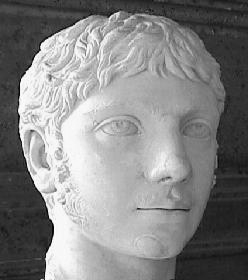 Elagabalus (or
Heliogabalus) (218-222) Elagabalus (or
Heliogabalus) (218-222)
Elagabalus,
a Syrian named after the sun-god (El-Gabal or Heliogabalus) for which
he briefly served as priest, was only 14 when he ascended the throne.
He brought his Eastern ways with him to Rome – including the
requirement that all Romans worship Heliogabalus (also known as the Sol
Invictus or the "Unconquerable Sun') in place of Jupiter, the
traditional head of the Roman pantheon. Elagabalus then served as
a high priest as well as emperor in the process. The Romans were
not at all ready for such religious innovation. His behavior was
also even more scandalous than usual for Roman emperors (his crude
sexual adventures with both sexes and his marriage and divorce of five
women in rapid succession – including among them a Vestal Virgin – were
unpardonable sins in Roman eyes). Finally he and his mother were
assassinated by the Praetorian Guard – and his cousin was brought to
the throne.
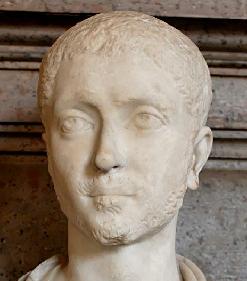 Alexander
Severus (222-235) Alexander
Severus (222-235)
Alexander
too was only 14 when he ascended the throne. In fact it was his
mother, Julia Mamaea, who was the real power behind the throne.
In general his reign was a stable one for Rome. He did what he
could to put Rome back on something of a moral-legal basis, he
attempted to place Rome's governmental structures on a more rational
footing, and he strengthened the economy by cutting back on
governmental extravagance, lowering taxes, improving the quality of
Roman coinage, placing controls on interest rates, etc.
His difficulties developed in the area of relations with the Roman
military. He never really had control over his armies – and
mutinies were frequent. But his troubles with the military came
to a head in his dealings with the new Persian Sassanid dynasty which
had arisen under Ardashir and his son Shapur. The Sassanids had
not only taken over the Parthian kingdom, but had extended Persian
control deep into Roman territory in the eastern reaches of the Roman
empire. When Alexander marched his army out to meet the Sassanids
in 232, the results were something of a standoff for both sides.
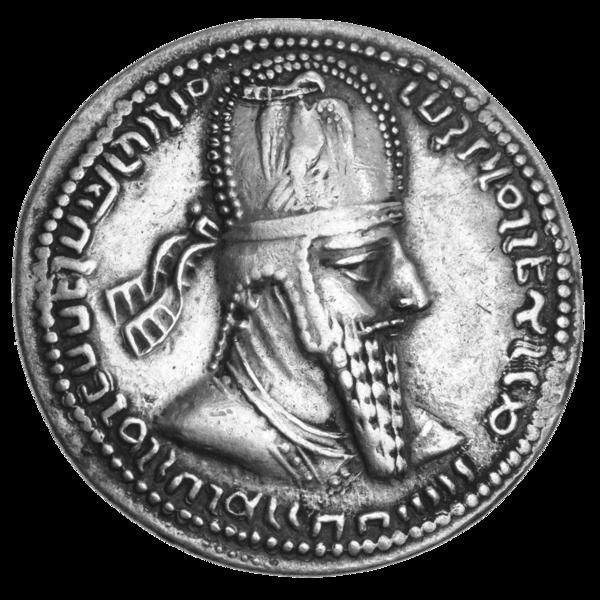 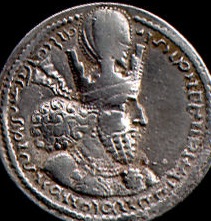
Sassanid kings Ardashir (224-240) and Shapur (240-270)
Two
years later Alexander led his armies out to expel the German armies
that had crossed the Rhine and had overrun eastern Gaul. He
crossed into Germany – and then offered to pay tribute to the Germans
rather than fight them to resolve the issue. The soldiers were
incensed – and plotted his removal and replacement by a soldier popular
among the troops. In 235 Alexander and his mother were both
murdered in a mutiny of his troops.
Maximinus Thrax
(235-238)
A Thracian peasant who was brought to
the imperial position by the military. He reversed Alexander's reforms
and restored military rule as the underpinning of the emperorship.
Marks the beginning of a period of decline of the Roman empire as contenders
to the throne vied in combat with each other. This permitted the
Allamanni and Franks to cross beyond the limes of the empire (along the
Rhine) in 236. In 237 the Goths crossed the Danube into the
Balkans at the other end of the Roman line of defence against the Germans.
Yet Another Lengthy Period
of Confusion (238-253)
The confusion of competing would-be
emperors backed by their own armies which started during the reign of Maximinus
only increased in the period after him. During the next 15 years
emperors came and went in rapid succession--with more than one figure claiming
that title at the same time.
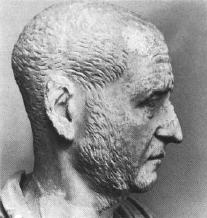
Decius
(249-251)
201-251. Decius was one of those
short-lived imperial figures. He was a major persecutor of the Christians.
He ordered a general sacrifice to the emperor to be conducted around the
empire--and for those refusing to do so to be dealt with harshly.
Decius was killed in a battle to
stop the flow of the Goths--who were crossing the Danube at will.
Valerian (253-260)
193-260. He also ordered a massive round
of persecution of Christians.
As the Romans were pushed to the
defensive against the German onslaught against the Empire in the North,
the Persians were undergoing a revival of power under the new Sassanid
dynasty and began to pose a major threat to Roman power in the East.
The Sassanids laid claim to all the Asian provinces of Rome, and attacked
Antioch. In 259, Valerian, trying to organize a defense, was captured
in this battle. In 260 the Persians succeeded in capturing Antioch.
Valerian died in captivity in that same year.
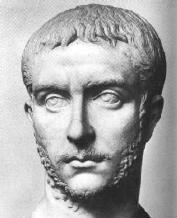
Gallienus
(260-268)
Son of Valerian. During his rule
the chaos descending on Rome reached a peak. The Roman districts
in Germany beyond the Rhine were lost, never to be recovered. A Gothic
navy of 500 ships harrassed Asia Minor and even Greece itself--sacking
Athens, Corinth and Sparta. Roman legions had to operate pretty much
on their own because of the lack of power at the Roman political center.
Cassianius Latinius Postumus (259-269)
M. Cassianius Latinius Postumus was
not an emperor but a local Roman ruler during the chaotic reign of Gallienus.
Backed by the Roman legions of Gaul, Spain and Britain, he established
a provincial empire of his own in the West (Gaul). The regionalization
of power permitted the restoration in Gaul of security from the attacks
of the invading Germans.
Odaenathus ( -266)
Not an emperor--but another regional
Roman ruler during the reign of Gallienus. As governor of the East,
he drove the Persians from Asia Minor and Syria, even recovering Mesopotamia
for Rome. He ruled--as a sovereign by his own right as Prince of
Palmyra--Syria, Arabia, Armenia, Cappadocia and Cilicia. He was murdered
in 266.
Septimia Zenobia
(266-273)
Though the rulership of Odaenathus formally
went to his young son, Vaballathus, in fact it was his wife, Septimia Zenobia,
who ruled after him. She extended her rule into Egypt--and declared
the independence of Palmyran rule from Roman authority.
Aurelian (270-275)
212-275. Aurelian restored central
Roman authority, destroying Palmyran rule in 273 and bringing Zenobia to
Rome in chains. In 274 he brought an end to the independent Gallic
empire in the West, bringing Gaul back under direct Roman rule. He
rebuilt the defenses along the Danube. He even built fortifucations
around the imperial city of Rome itself--a sign of the trouble of the times.
In 275 he was assassinated by some
of his officers.
Probus (276-282)
Defeated the Franks and Alemanni and
secured the Rhine defenses again.
Carus (282-283)
In 282 Carus restored Armenia and Mesopotamia
to Roman rule and reestablished the old boundaries of Septimus Severus.
 Diocletian
(284-305) Diocletian
(284-305)
235-313. Diocletian attempted
a number of reforms designed to strengthen the greatly weakened Empire.
He divided the Empire into two parts: Eastern and Western.
The Eastern part comprising Asia Minor and Egypt he himself ruled directly
from his capital in Nicomedia. The Western part comprising Italy
and Africa he assigned in 286 to Maximinian, "co-Augustus" with himself,
who was to rule from Milan.
In 293 he chose Galerius as his successor
as Caesar and Maximinian chose Constantius as his successor--freeing
themselves to their work as supreme princips or
Augusti. Thus
a quadripartite rule was established.
In 303, deeply worried about the
rising influence of the Christians in the Empire, Diocletian ordered a
major round of persecution against the Christians in his eastern territories.
This lasted through the rest of his reign--indeed until 313
In 305 both Diocletian and Maximinian
abdicated their rule, leaving power to Galerius and Constantius.
Diocletian retired to his huge villa at Salona (Split) in modern Croatia
and lived out the rest of his 8 years there.
Maximian (286-305)
Constantius I
Chlorus (305-311)
Joint rule with
Galerius : 305-311
Galerius (305-311)
Joint rule with
Constantius I Chlorus: 305-311.
Licinius (308-324)
Licinius was an Illyrian peasant who
rose through the ranks of the Roman Army--and in 308 was named "Augustus"
(junior ruler) by Galerius. In 311, with the death of Galerius, he
received Galerius's political holdings in the West. Two years later
he defeated in battle the Emperor of the East, Maximinius, and took his
holdings.
But Constantine had also been building
his strength as "Augustus" and despite their earlier friendship (Licinius
was even married to Constantine's half-sister Constantia) Constantine forced
Licinius to give up lands to him. Finally in 324 the two met in battle
and Licinius was stripped of his powers. The following year he was
executed on charges of conspiring against Constantine.
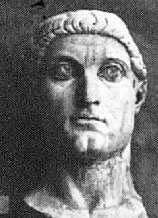 Constantine
the Great (311-337) Constantine
the Great (311-337)
273-337. Constantine was a Roman
Emperor ruling jointly with Licinius from 311 to 324 and solely thereafter
until his death in 336.
We remember him most importantly
for his conversion to Christianity in 312, which opened the way for the
adoption of Christianity as the official religion of Rome, and for his
establishing in 330 a new Roman capital in the East at Byzantium, just
across from Asia Minor.
He was originally a worshipper of
the Unconquered Sun, a widely popular religion in that time. Interestingly,
even as Constantine came to honor Christ, he retained loyalty to this god,
even establishing the first day of the week as the holy day: "Sun" day.
His conversion to Christianity came
in 312 at the Battle of Milvian Bridge--through a series of miracles and
vows which brought him to faith in Jesus Christ.
Within six months of his conversion
he was asked by the Donatists in North Africa to intervene in their dispute
with "apostate" bishops (ones who had at one point denied their faith under
the pressure of persecution) whose authority the Donatists no longer recognized.
Constantine did intervene--but found in favor of the restored bishops against
the Donatists, and ordered the Donatists to submit to the authority of
these bishops.
He went from there to become increasingly
active in imposing "order" on his new church--seeing this as his imperial
duty to God (as always had been the understanding of the Emperor's responsibility
to the empire: that is, to be the "defender of the faith").
He was responsible for calling the
Council of Nicea (325) to decide the dispute between Alexander, Bishop
of Alexandria and his presbyter, Arius--who had come to espouse a monarchian
or "unitarian" position. The Council itself decided in favor of Alexander--and
outlined the basics of the "Nicene Creed," which stood at the heart of
"Trinitarian" Catholic doctrine.
Though Constantine stood firmly behind
the Council and its decision, he himself remained quite tolerant of the
unitarian Arians--who were widely popular in the East (where the Nicene
"Trinitarian" decision itself was unpopular). Rumors were that he
himself had Arian sympathies--but kept them to himself in order to preserve
the religious unity of his domain.
Triumvirate of
Constantine II, Constantius II and Constans (336-350)
Upon Constantine's death in 337 the
empire was divided up among his three sons. They intrigued and fought against
each other--and others--until in 354 Constantius held position as sole
Roman emperor.
Constantius II
(354-361)
Constantius was a fervent Arian and
intimidated the bishops into an anti-Nicene position. At the same time,
pursuing religious conformity within his empire, he pushed the Christian
cause against paganism more forcefully than his father had--closing the
temples in 356 and removing the alter of Victory from the Roman Senate
in 357.
Julian (361-363)
Called the "Apostate" for his efforts
to end Christianity's religious monopoly and restore pagan worship to prominence
in Rome--even though he himself was raised in his youth as a Christian.
Julian was a nephew of Constantine
who had miraculously escaped the murderous intrigues that took the life
of most of the rest of his family in 337. Upon finally becoming emperor
himself, he disclosed his pagan loyalties and began to try to undo the
work of his Christian uncle Constantine and cousin Constantius. He
tried to substitute a new religion based on Platonism in which the Supreme
Being was identified with the Sun God Helios (akin to the popular Mithras).
He tried also to establish the same moral rigor for his faith that made
Christianity so respectable--and even copied the ecclesiastical organization
of the Christian church.
He did not directly persecute Christianity
but did remove Christianity's privileged position within the government
and forbade Christians from teaching in the public schools (in an effort
to bring the empire back to its pre-Christian traditions through the children).
But there was no real zeal among the populace for his reforms--which became
quickly apparent soon after he took over. This really closed the
book for traditional paganism.
Jovian (364-365)
Valentinian I
(West 364-375)
Western Roman Emperor
Valens (East 364-378)
Eastern Roman Emperor – brother of Valentinian
I.
In 370 Huns poured into Eastern Europe
from Asia, pressing the German-speaking Goths who inhabited the area. Emperor
Valens permitted the Goths (Visigoths or Western Goths) to settle inside
of traditional Roman lands, hoping that they would serve as a buffer to
the Huns. But soon both the Visigoths and their close kinsmen the Ostrogoths
(Eastern Goths) joined forces to defeat the Eastern Roman armies – establishing
Gothic autonomy within the Roman Empire. Eventually many of them were brought
into the Roman army in the hope that they would add vigor to the declining
Roman military power.
Gratian (West
jointly 375-383)
Joint Western Emperor (367-375)
with his father Valentinian until the latter's death in 375 and then with
his 4-year old brother Valentinian II.
The Empire was under constant attack
from Germanic tribes and he spent his rule mostly in Gaul fighting off
the Goths.
In 383 he marched his army against
the usurper of Roman power in Britain, Magnus Maximus. But his tooops
deserted him and he was murdered during his attempt to escape.
Valentinian
II (West jointly 375-383; solely 383-392)
Emperor of the West: jointly with
Gratian from 375 to 383 and solely thereafter until 392.
Theodosius I (East
379-392; East and West 392-395)
346?-395. Eastern Roman Emperor
from 379 to 392. After 392 until 395 he ruled both East and West.
He called the Christian Council of Constantinople.
Symmachus (345-410)
Quintus Aurelius Symmachus was not a
Roman Emperor--but was however a strong voice of the old pagan viewpoint
in the Roman Senate. His life of public service, his sterling moral
character and his wealth and personal influence made him an outstanding
spokesmen against the Christian ascendancy in Rome. In 382 he was
expelled from Rome after his strong protest over the removal of the statue
and altar to Victory in the Senate chamber. He was restored to influence
soon thereafter (prefect of the city of Rome), but proved to be still as
adamant as ever over this issue, appealing to to Emperor Valentinian to
restore these symbols of traditional Rome.
Stilicho (394-408)
Flavius Stilicho was not a Roman emperor--but
a mighty political force in the Empire that at times exceeded in power
the position of the Western Emperor.
He was born to a German Vandal officer
in the Roman army of emperor Valens. Stilicho himself joined the
imperial army and rose quickly up the ranks. In 383 he was sent by
Emperor Theodosius as a diplomatic envoy to the Persian King Sapor.
On his successful return he was brought into the imperial family by marrying
the Emperor's niece/adopted daughter, Serena.
In 385 he began a very successful
military career: in Thrace against the Goths, in Britain against
the Picts, Scots and Saxons, and along the German Rhine.
In 394, with his wife Serena, he
was appointed regent over the youthful joint emperor, Honorius – bringing
Stilicho into the thick of imperial politics. His main rival to his
deep political ambitions was Rufinus. In order to bring him down
Stilicho marched his army to the east to meet Rufinus, but then had Rufinus
assassinated. This made Stilicho the virtual dictator of the Roman
Empire.
In 396 he was drawn into Greece to
fight Alaric and the Visigoths--but
worked out a diplomatic settlement with Alaric instead.
By the year 400 he was consul – and
also father-in-law to Honorius.
In 401-402 he was called to action
again against Alaric (and Alaric's ally Radagaisus) – this time along the
Danube and in Italy. Once again he was successful in delivering the
Empire from this Barbarian threat through military victory and diplomatic
settlement. But in 405 Radagaisus again invaded Italy. This
time Stilicho starved Radagaisus to defeat.
In 408 Stilicho began to strengthen
his hold over Honorius with the marriage of his second daughter to the
Emperor. But then he was accused of plotting to overthrow his son-in-law
in order to establish himself as Emperor. Whatever the truth of the
matter, Stilicho fled to Italy, taking sanctuary in Ravenna. He was
brought out by a promise of safe-conduct – but was seized and executed nonetheless.
Honorius (394-423)
Emperor of the West, whose political
fortunes during the first 14 years of his rule were closely tied to Stilicho.
Arcadius (395-408)
c. 377-408. Emperor of the East, brother
of Honorius. It was during his reign that Alaric
invaded Greece.
Theodosius II
(East 408-450)
Valentinian
III (West 423-455)
|








 The Israelites/Jews (Spiritual Pilgrim)
The Israelites/Jews (Spiritual Pilgrim)


 Miles
H. Hodges
Miles
H. Hodges